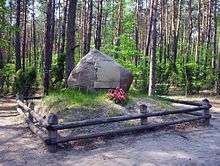Battle of Wólka Węglowa
| Battle of Wólka Węglowa | |||||||
|---|---|---|---|---|---|---|---|
| Part of Invasion of Poland | |||||||
| |||||||
| Belligerents | |||||||
|
|
| ||||||
| Commanders and leaders | |||||||
|
|
| ||||||
| Strength | |||||||
|
2 cavalry regiments (1,000 men) | 2,300 men and 37 tanks | ||||||
| Casualties and losses | |||||||
|
105 killed 100 wounded |
52 killed 70 wounded | ||||||
Battle of Wólka Węglowa (Polish: Bitwa pod Wólką Węglową) refers to the battle on September 19, 1939, that took place near Wólka Węglowa (near Warsaw), during the last stages of the Polish counteroffensive (Battle of the Bzura) of the Invasion of Poland.[1]
Outcome

The battle of Wólka Węglowa was a cavalry battle, as Polish Uhlan cavalry (14th Regiment of Jazlowiec Uhlans of Podolska Cavalry Brigade and elements of the 9th Regiment of Lesser Poland Uhlans) retreating towards Warsaw encountered German units. The commanding officer of the 14th Regiment, Col. Edward Godlewski ordered a cavalry charge. German infantry was taken by surprise, but machine guns and tanks hidden nearby opened fire on the cavalry. Eventually Polish units broke through towards Warsaw, as intended, but at the cost of heavy losses (105 killed, 100 wounded - about 20% of their initial strength).
The battle was witnessed and described by Italian war correspondent Mario Appelius.
References
- ↑ Herz, Lechosław (2012). Puszcza Kampinoska. Przewodnik. Warsaw: Oficyna Wydawnicza "Rewasz". p. 89. ISBN 8362460180.
- Krzysztof Komorowski, Boje Polski 1939, Przewodnik encyklopedyczny.
- Herz, Lechosław (1990). Przewodnik po Puszczy Kampinoskiej. Warszawa: Wydawnictwo Sport i Turystyka. pp. 268–269. ISBN 83-217-2258-X.
- Jerzy Korczak (1983). Cóżeś ty za pani...: O walkach armii "Poznań" 12-19 września 1939r. Poznań: Wydawnictwo Poznańskie. pp. 297–301. ISBN 83-210-0424-5.
Coordinates: 52°17′45″N 20°53′02″E / 52.295896°N 20.883926°E